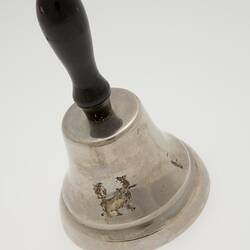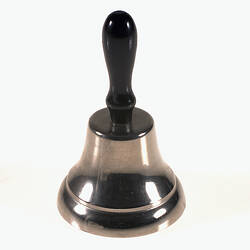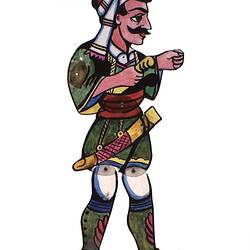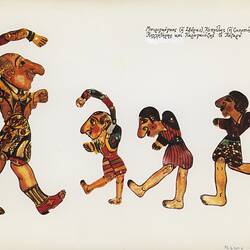Summary
This bell was purchased in Melbourne in 1978 by Dimitri Katsoulis and he used it in his subsequent performances in Victoria and in South Australia from 1978 to 1991. Dimitri Katsoulis migrated to Australia in 1974 to escape a regime that repressed Greek artists. He had trained in Greece with theatre and film companies as an actor and technician. A master of the traditional Greek shadow puppet theatre, his performances explored contemporary issues such as the isolation of migrant women and children. Unable to obtain funding and support, he returned to Greece in 1991, leaving his entire collection to the people of Victoria. It includes 32 shadow puppets and around 170 props, set backdrops and technical tools and stage equipment. Dimitri has since returned to Melbourne and assists the Museum to continue to document this rich art form within both local and international contexts.
This is the bell which the puppeteer rings to signify to the audience to be seated in the theatre as the puppet show is about to begin. The puppeteer rings it three (3) times. The first ring is for everyone to take their seats. The second ring is for silence in the theatre and the third time to signal the house lights to be switched off in the theatre and the stage lights to be switched on for the performance to begin.
Information supplied by Greek Shadow Puppet Theatre master Dimitri Katsoulis, 2007.
Physical Description
A silver handbell with black wooden handle. A groove runs around the circumference, about 1 cm above the base. The remnant of a price sticker and some adhesive remain on the side.
Significance
This collection of puppets, props, stage sets, and technical tools and equipment relating to traditional Greek Shadow Puppet Theatre is unique in Australia and rare in international public collections. The history of Greek Shadow Puppet Theatre, its puppet characters and the methodology of its performance has been recorded in partnership with the puppet master to whom the collection belonged. The collection is highly significant both as documentation of an important cross-cultural, centuries-old art form, and as an example of the transnational migration of cultural activity between Greece and Australia. It is a collection which was created and performed in Greece and Australia from the mid to late twentieth century, by two puppet masters, who transported the tradition between two countries. Abraam Antonakos came to Australia in 1977 to perform the puppet theatre and then deposited the puppets with Dimitri Katsoulis, who had migrated to Australia in 1974. Dimitri's story becomes one of migration experience, cultural maintenance and adaptation, and finally return migration and the discontinuance of this cultural art form in Australia.
More Information
-
Collection Names
-
Collecting Areas
-
Acquisition Information
Purchase
-
Date Purchased
Mr Dimitri Katsoulis, Melbourne, Greater Melbourne, Victoria, Australia, 1978
-
Place & Date Used
Mr Dimitri Katsoulis, Melbourne, Greater Melbourne, Victoria, Australia, 1978-1991
-
Inscriptions
Printed on remains of paper price tag, on side of bell, "S"
-
Classification
-
Category
-
Discipline
-
Type of item
-
overall dimensions
8 cm (Length), 8 cm (Width), 12.5 cm (Height)
-
Exhibition Collection Management
80 mm (Length), 80 mm (Width), 125 mm (Height)
-
References
[Link 1] Malkin, Michael, R. Traditional and Folk Puppets of the World, A.S. Barnes & Co., Inc., N.J., 1977; Simmen, Rene, The World of Puppets, Elsevier, Phaidon, London, 1975; Hogarth, Ann & Bussell, Jan, Fanfare for Puppets!, David & Charles Publishers Ltd, USA, 1985; Yayannos, A & Ar and Dingli, J. The World of Karaghiozis, 1976
-
Keywords
Cultural Maintenance, Greek Communities, Greek Immigration, Karaghiozis Theatre, Shadow Puppetry, Theatres, Working Life





